Transportation emissions are the number one source of greenhouse gases in California and many other advanced economies. Our reports present options to reduce these emissions, with a focus on clean fuels through greater adoption of zero-emission vehicles and use of low-carbon biofuels, as well as for reducing the need for driving through enhanced public transit options and improved freight delivery systems.
January 2024
In pursuit of the state’s goal to end the sale of new internal combustion engine passenger vehicles by 2035, California leaders face a critical challenge in ensuring equitable access to zero-emission vehicles (ZEVs), particularly for lower- and moderate-income residents. A significant barrier to this transition is the limited access to electric vehicle (EV) charging stations, especially in communities with lower home ownership rates and inadequate grid infrastructure. To address these challenges and ensure more and equitably distributed chargers across California, state and local policymakers can learn lessons from representative communities and the practical challenges they face to installing EV chargers.
To further this objective, UC Berkeley School of Law’s Center for Law, Energy & the Environment (CLEE) partnered with Watsonville, a diverse city of 50,000 in Santa Cruz County’s agricultural heartland. Due to its location, demographics, and ambitious policy goals, Watsonville represents a potential model and case study for other cities around the state grappling with how to boost zero-emission vehicle charging infrastructure.
November 2023
The movement of goods through the Ports of Los Angeles and Long Beach is a major source of air pollution and greenhouse gas emissions in the L.A. region. The South Coast Air Quality Management District has reported that the Ports are “the single largest fixed source of air pollution in Southern California.” And neighboring communities—predominantly low-income communities of color—bear the brunt of this pollution, suffering from smog and toxic air pollution from port equipment.
This new report surveys the biggest obstacles to speedy electrification, including inadequate grid and charging infrastructure, evolving zero-emission technology for cargo handling equipment, and fear among communities and workers of job loss and of increased emissions from expanded port activities. The report also presents policy solutions to get around these obstacles.
September 2023
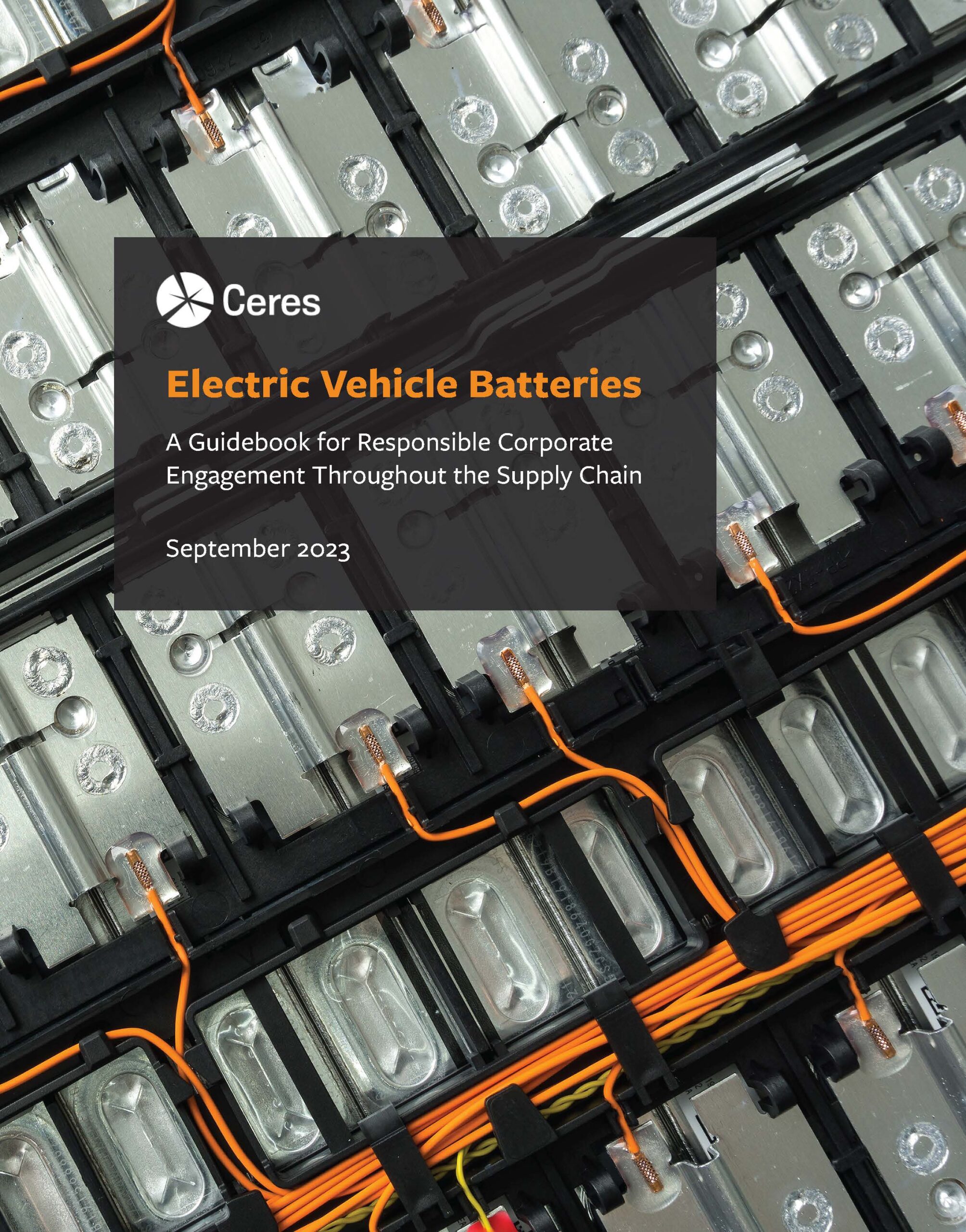
The Corporate Electric Vehicle Alliance (opens in a new tab)(CEVA), led by Ceres, is a collaborative group of companies focused on accelerating the transition to EVs. Our new report for CEVA, in partnership with Ceres, offers recommendations for major corporate EV fleet purchasers for how they can help ensure EV supply chain sustainability. It summarizes the market status of the batteries, U.S. policy context, and key initiatives for improvement.
Access the full report here: Electric Vehicle Batteries: A Guidebook for Responsible Corporate Engagement Throughout the Supply Chain
Read more about our larger initiative here: Building a Sustainable Electric Vehicle Battery Supply Chain
October 2022
Policy Options for Sustainable Aviation in California
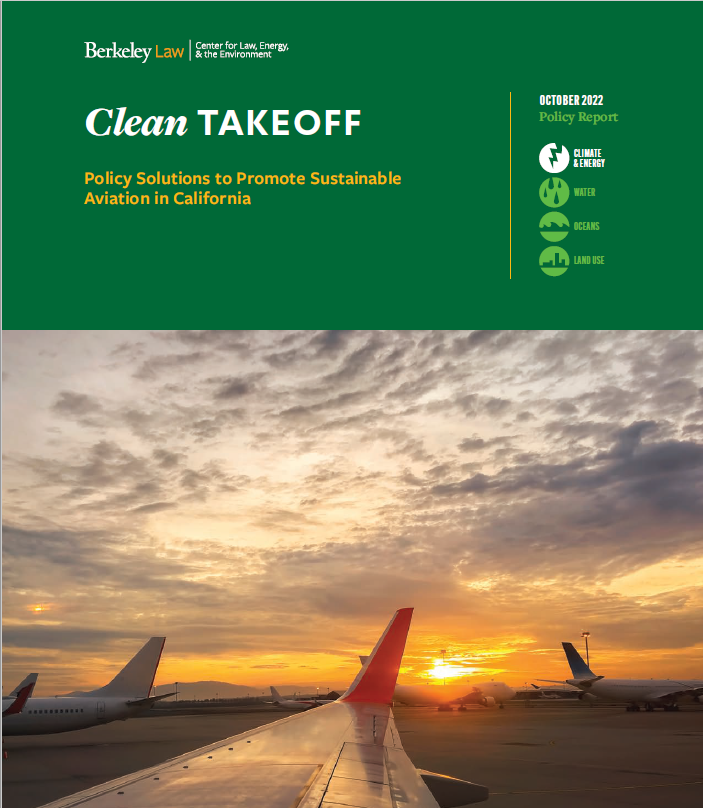
Airplane travel is responsible for more than 2 percent of global carbon dioxide (CO₂) emissions, with non-CO₂ emissions raising the total climate impact further. While no existing zero-emission technologies can power all flights today, sustainable aviation fuel represents the most promising immediate solution to reduce emissions from aviation and will remain key to decarbonizing long-haul aviation, even in 2050.
In response, Governor Newsom called for a 20 percent clean fuels target for the aviation sector in July 2022, and the steps described in Clean Takeoff could help the state achieve those goals while maximizing air quality and economic co-benefits in communities near airports and production facilities.
March 2022
No Time to Waste: Governing Cobalt Amid the Energy Transition
Cobalt is critical. Along with other critical minerals, cobalt has important economic uses and currently few viable substitutes, yet its supply faces a high risk of disruption. Manufacturers of batteries for electric vehicles (EVs) want the metal. EV sales—and likewise, cobalt demand— could grow a lot more.
Yet, cobalt may not remain critical for decades to come. EV buyers, battery manufacturers and miners fear the high prices and disrupted supply, as well as human right abuses, environmental destruction, corruption, and political risk. As with other critical minerals, industries are seeking to use less of the metal. The time available for the Democratic Republic of Congo (DRC) and other countries to benefit from mining the metal may be short-lived.
Given this, proper governance is important both for people in mining countries and for humanity to meet the Paris Climate Agreement. This report aims to help governments and their advisors in mining countries, such as the DRC, derive value from mining cobalt, develop industry along the battery-supply chains and address a host of problems from human rights abuses to corruption.
The report is also for policy-makers working to ensure that the world delivers enough cobalt in time for the global energy transition.
January 2022
Analyzing Rail Transit Project Costs and Delays
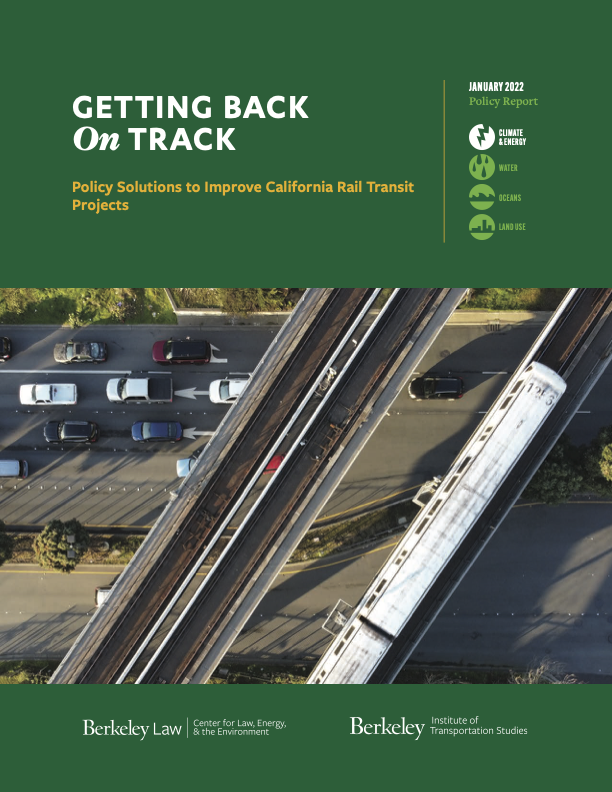 Increasing the reach and capacity of public transit networks, including rail transit, will be essential to reducing greenhouse gas emissions from transportation. But in California (and throughout the US), transit infrastructure projects have long suffered from cost overruns and deployment delays that reduce the value of investment and erode public trust.
Increasing the reach and capacity of public transit networks, including rail transit, will be essential to reducing greenhouse gas emissions from transportation. But in California (and throughout the US), transit infrastructure projects have long suffered from cost overruns and deployment delays that reduce the value of investment and erode public trust.
With funding from California SB 1 research dollars through the UC Berkeley Institute of Transportation Studies, CLEE analyzed national and international construction trends as well as five California rail case studies to identify overruns and delays, understand their causes, and develop policy solutions to avoid them in the future.
October 2021
Flexibility in California Transportation Funding Programs and Implications for More Climate-Aligned Spending
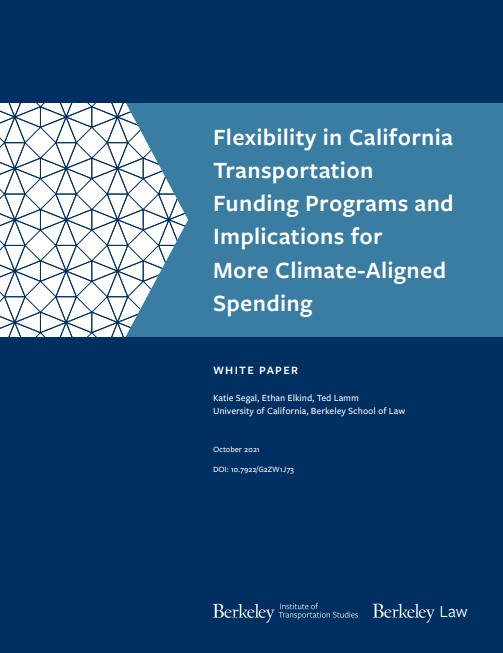 Assembly Bill 285 (Friedman, 2019) directed the Strategic Growth Council to develop a report on the California Transportation Plan (a roadmap for state transportation investment and planning through 2050), state and local funding sources, and opportunities to align state goals. CLEE joined with researchers at UC Berkeley Institute of Transportation Studies (ITS), UC Davis ITS, and UCLA ITS to prepare a series of white papers on select California transportation funding and planning topics to provide an evidentiary basis for the SGC report.
Assembly Bill 285 (Friedman, 2019) directed the Strategic Growth Council to develop a report on the California Transportation Plan (a roadmap for state transportation investment and planning through 2050), state and local funding sources, and opportunities to align state goals. CLEE joined with researchers at UC Berkeley Institute of Transportation Studies (ITS), UC Davis ITS, and UCLA ITS to prepare a series of white papers on select California transportation funding and planning topics to provide an evidentiary basis for the SGC report.
CLEE’s white paper, Flexibility in California Transportation Funding Programs and Implications for More Climate-Aligned Spending, examines key features of the legislative authority for transportation planning and finance in California, including local option sales taxes for transportation, and assesses the amount of flexibility that current laws and practices allow for reprioritizing projects as problems and priorities change. The report seeks to answer questions including the nature of limitations on spending flexibility in state and local funding programs; the role of CEQA review in transportation funding programs; and the potential to reallocate funding or modify prior commitments to better address climate-related goals.
July 2020
Sustainable Drive, Sustainable Supply: Priorities to Improve the Electric Vehicle Battery Supply Chain
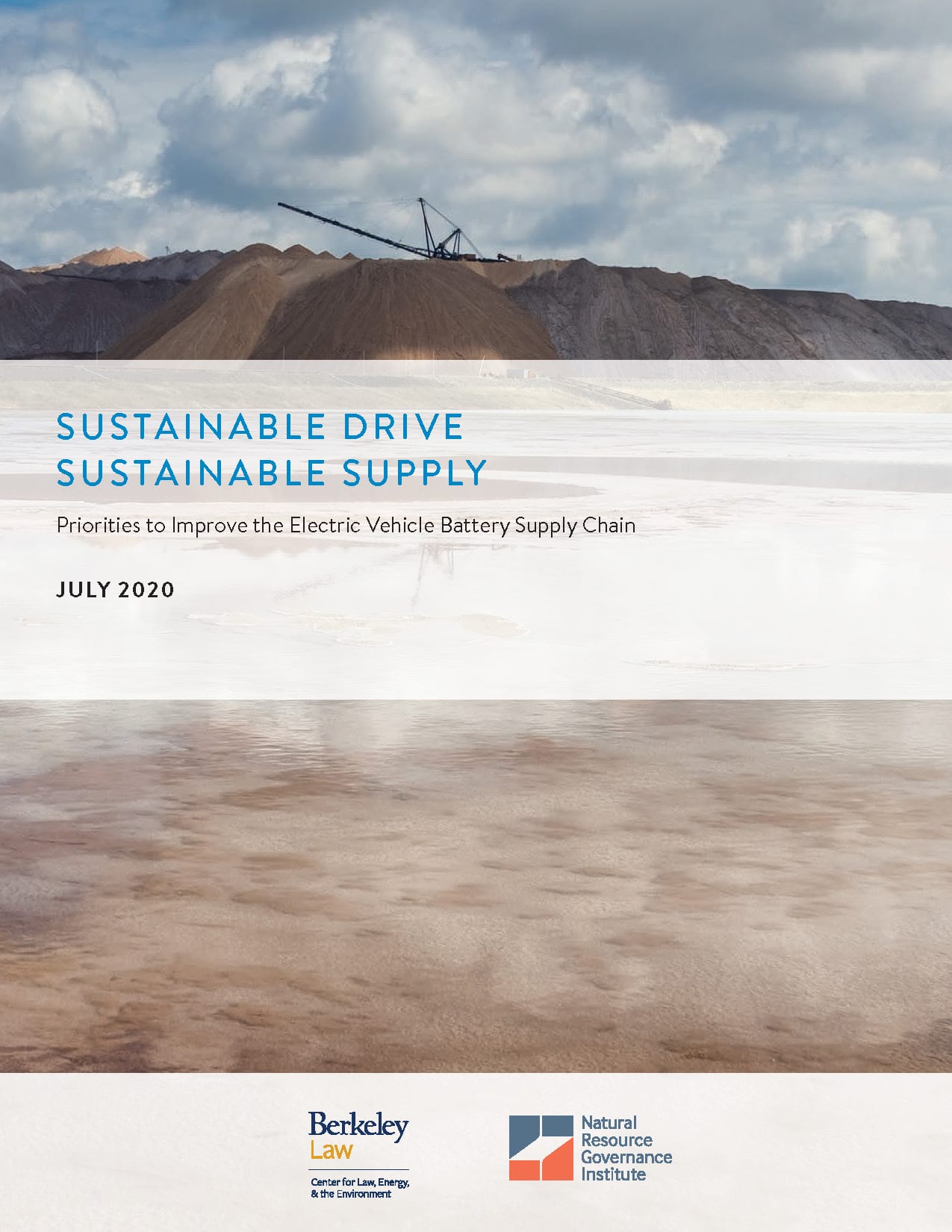 The global transition from fossil fuel-powered vehicles to battery electric vehicles (EVs) will require the production of hundreds of millions of batteries. This massive deployment frequently raises questions from the general public and critics alike about the sustainability of the battery supply chain, from mining impacts to vehicle carbon emissions.
The global transition from fossil fuel-powered vehicles to battery electric vehicles (EVs) will require the production of hundreds of millions of batteries. This massive deployment frequently raises questions from the general public and critics alike about the sustainability of the battery supply chain, from mining impacts to vehicle carbon emissions.
To address these questions, CLEE and the Natural Resource Governance Institute (NRGI) are conducting a stakeholder-led research initiative focused on identifying strategies to improve sustainability and governance across the EV battery supply chain. The new report “Sustainable Drive, Sustainable Supply: Priorities to Improve the Electric Vehicle Battery Supply Chain” identifies key challenges and possible responses that industry, government and nonprofit leaders could take to ensure battery supply chain sustainability.
April 2020
Building a Sustainable Electric Vehicle Battery Supply Chain: Frequently Asked Questions
November 2019
Electric Vehicles and Global Urban Adoption
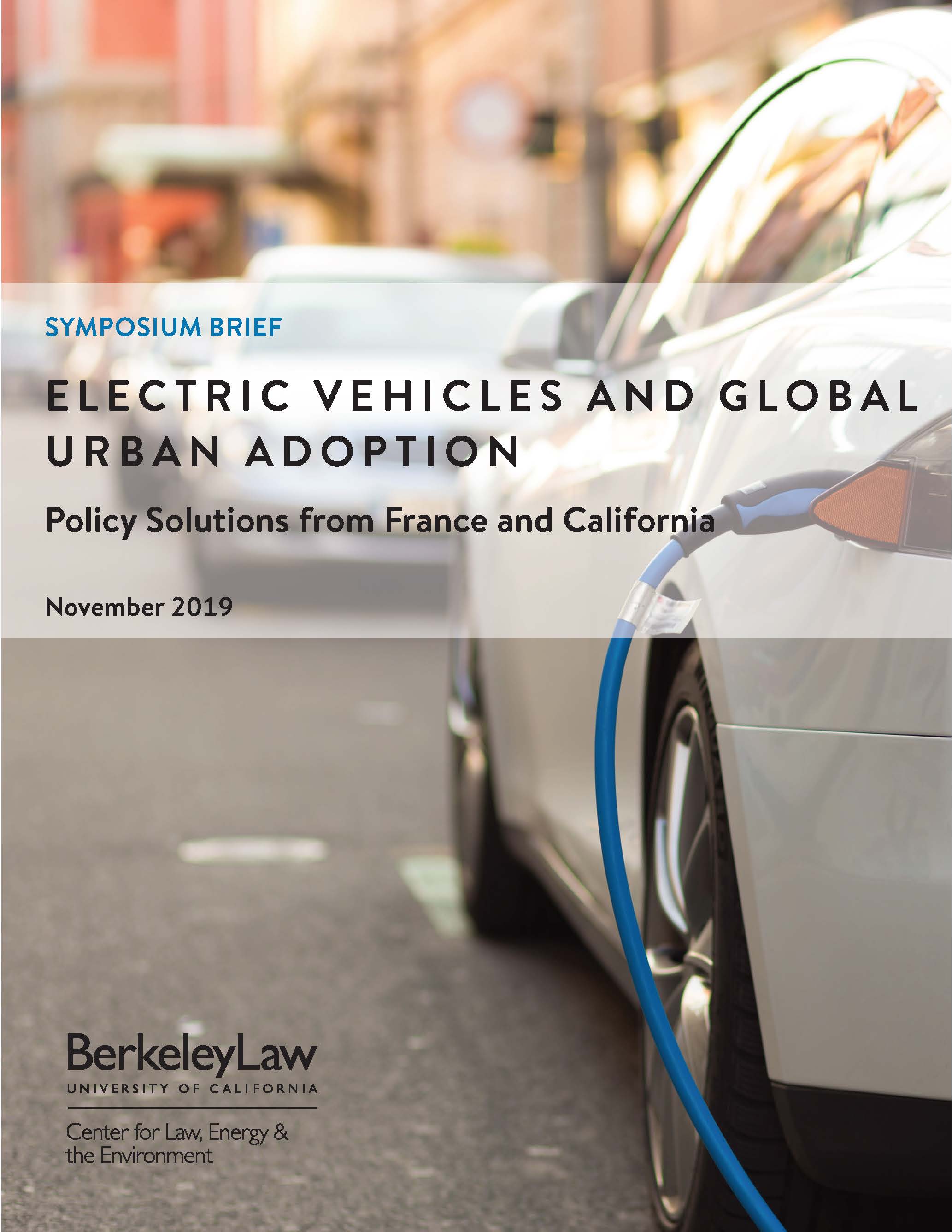 California and France have taken leading steps in supporting the transition to electric vehicles (EVs), but each has substantial progress ahead to reach full adoption. What can these jurisdictions learn from each other’s successes and challenges to make EVs convenient and accessible to urban residents?
California and France have taken leading steps in supporting the transition to electric vehicles (EVs), but each has substantial progress ahead to reach full adoption. What can these jurisdictions learn from each other’s successes and challenges to make EVs convenient and accessible to urban residents?
To explore these questions, speakers at our June 2019 international conference at UC Berkeley on electric vehicles and global urban adoption, co-sponsored by CentraleSupélec and Florence School of Regulation (FSR) in France, described lessons learned for electric vehicle deployment in France and California.
Based on the discussion, UC Berkeley Law’s Center for Law, Energy and the Environment (CLEE) released the symposium brief: Electric Vehicles and Global Urban Adoption: Policy Solutions from France and California.
December 2018
Streamlining Sustainability: Regulatory and Permitting Improvements to Achieve California’s Freight Goals
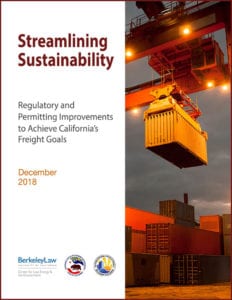 Freight is responsible for hundreds of thousands of jobs in California and feeds commerce and agriculture throughout the state and the entire nation. But the trains, trucks, aircraft, and ocean vessels that ship goods throughout California are responsible for a disproportionate amount of greenhouse gas emissions and harmful air pollutants.
Freight is responsible for hundreds of thousands of jobs in California and feeds commerce and agriculture throughout the state and the entire nation. But the trains, trucks, aircraft, and ocean vessels that ship goods throughout California are responsible for a disproportionate amount of greenhouse gas emissions and harmful air pollutants.
California’s freight system leaders will need to maximize its efficiency to retain this position of prominence while protecting California residents and workers. The recommendations outlined in Streamlining Sustainability can help California achieve its ambitious emission reduction, public health, and economic competitiveness goals.
October 2018
Implementing SB 743: An Analysis of Vehicle Miles Traveled Banking and Exchange Frameworks
California law requires developers of new projects, like apartment 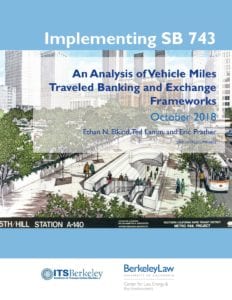 buildings, offices, and roads, to reduce the amount of overall traffic the projects generate. To facilitate compliance with this new requirement under Senate Bill 743 (Steinberg, 2013), some state and local leaders seek to create special “banks” or “exchanges” to allow developers to fund off-site projects that reduce driving miles, such as new bike lanes, transit, and busways.
buildings, offices, and roads, to reduce the amount of overall traffic the projects generate. To facilitate compliance with this new requirement under Senate Bill 743 (Steinberg, 2013), some state and local leaders seek to create special “banks” or “exchanges” to allow developers to fund off-site projects that reduce driving miles, such as new bike lanes, transit, and busways.
Our new report, Implementing SB 743, provides a comprehensive review of key considerations for local and regional agencies tasked with crafting these innovative mechanisms to reduce vehicle miles traveled (VMT) and overall emissions.
September 2018
100% Zero: Solutions to Achieve Universal Zero-Emission Vehicle Adoption
Some countries and states, including California, are contemplating or 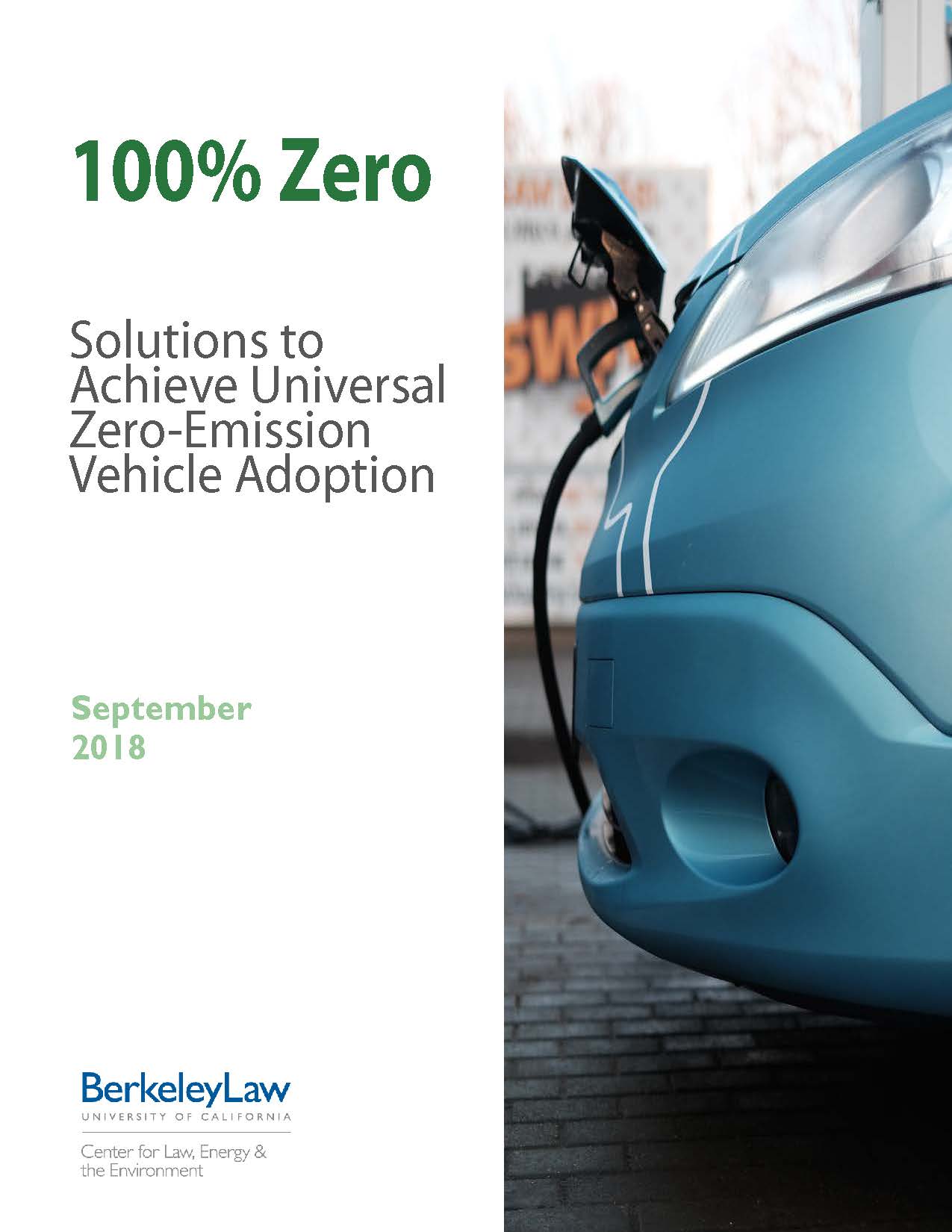 making plans for phase-outs or bans on the sale of new internal combustion engine passenger vehicles by a date certain. Such a phase-out would be critical to achieving long-term climate goals and improving public health.
making plans for phase-outs or bans on the sale of new internal combustion engine passenger vehicles by a date certain. Such a phase-out would be critical to achieving long-term climate goals and improving public health.
In California, the state will eventually need full consumer adoption of zero-emission vehicles in order to achieve legislated long-term climate goals. To that end, Governor Brown set a goal of reaching five million zero emission vehicles (ZEVs) on California’s roadways by 2030, including 250,000 public chargers by 2025, and as of mid-2018, Californians were driving over 400,000 electric vehicles.
100% Zero identifies key challenges and solutions to achieving a scenario in which 100 percent of new vehicle sales are zero-emission, based on a convening of expert stakeholders.
August 2018
Policy Solutions to Boost Zero-Emission Freight at Southern California’s Ports
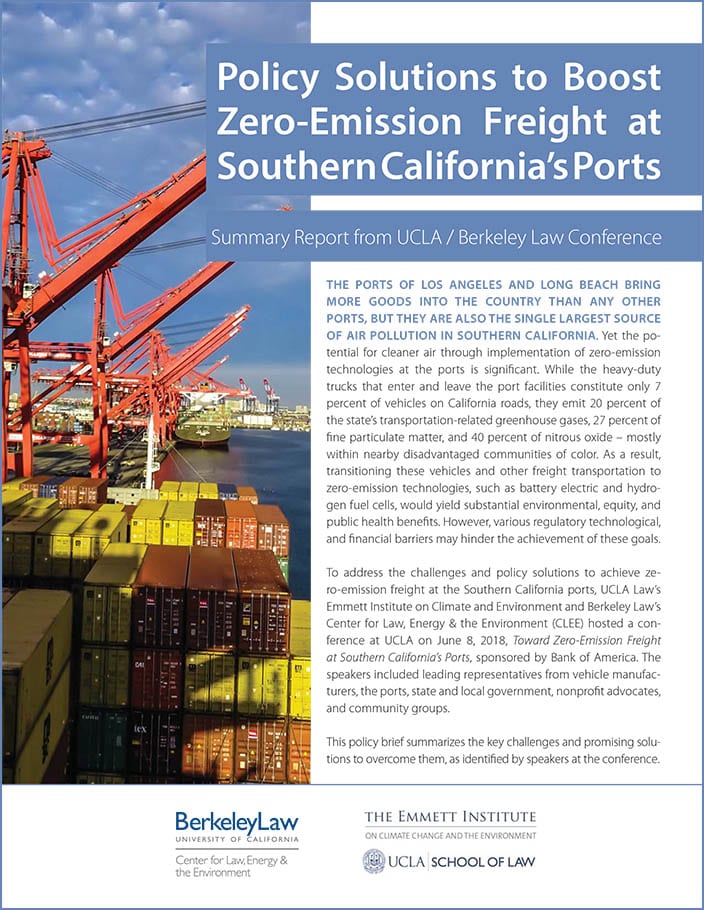 Transitioning freight transportation to zero-emission technologies, such as battery electric and hydrogen
Transitioning freight transportation to zero-emission technologies, such as battery electric and hydrogen
fuel cells, would yield substantial environmental, equity, and public health benefits. However, various regulatory technological, and financial barriers hinder the achievement of these goals. To address the challenges and policy solutions to achieve zero- emission freight at the Southern California ports, UCLA Law’s Emmett Institute on Climate and Environment and the Center for Law, Energy & the Environment (CLEE) hosted a conference at UCLA on June 8, 2018, Toward Zero-Emission Freight at Southern California’s Ports.
Our Summary Report outlines the main challenges and opportunities suggested in this day-long conference.
March 2018
Delivering the Goods: How California Can Create the Sustainable Freight System of the Future
California’s freight system is responsible for 1/3 of statewide jobs, as well as a major source of both greenhouse gas emissions and local air pollution in the state. New innovations in technology and infrastructure have the potential to improve efficiency and reduce pollution, but policy and industry support will be essential to achieve California’s environmental goals.
Key findings: Our report identifies an expansive group of new freight transportation technologies and infrastructure developments and the policy innovations needed to make them reality in California.
June 2017
Plugging Away: How to Boost Electric Vehicle Charging Infrastructure
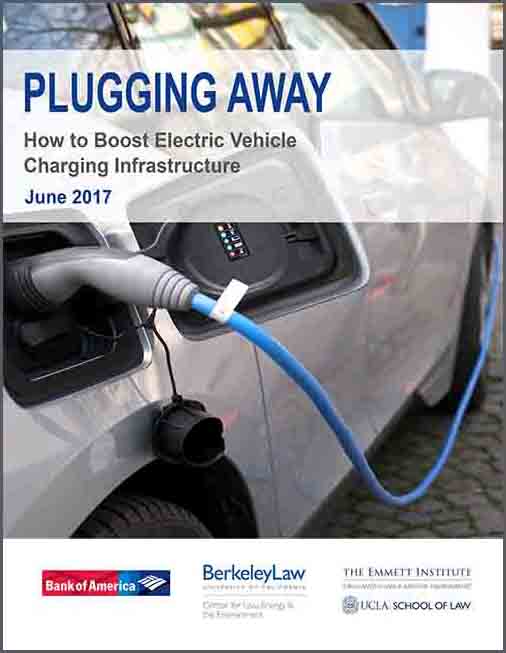 California will need widespread consumer adoption of electric vehicles (EV) in order to achieve the state’s environmental and energy goals. But achieving these goals will require a significant boost to EV charging infrastructure, particularly in workplaces, multi-unit dwellings, and fast charge “plazas.”
California will need widespread consumer adoption of electric vehicles (EV) in order to achieve the state’s environmental and energy goals. But achieving these goals will require a significant boost to EV charging infrastructure, particularly in workplaces, multi-unit dwellings, and fast charge “plazas.”
Key policy recommendations: expanded utility investments, at least up to the wiring of new charging stations; reform of commercial electricity rates to encourage more optimal charging times and locations based on grid needs; and expedited permitting and energy data access for charging stations in the most strategic locations to boost EV adoption.
December 2015
Planting Fuels: How California Can Boost Local, Low-Carbon Biofuel Production
Transportation fuels from fossil sources represent the single largest source of carbon emissions in California. Low-carbon biofuels, which are derived from agricultural sources as well as alternative sources such as algae and food, reduces petroleum fuel consumption as a substitute fuel. Yet California is missing opportunities to produce more of this biofuel locally, with attendant environmental and economic benefits.
Key policy recommendations: The grades reveal that high-performing stations are often in the middle of transit systems in downtown-like environments, while the poorest-performing stations are often located at the outer edges of the rail systems and the urban areas. Low density, auto-oriented areas, even when graded against similar place types, scored poorly.
Also see the webinar and Op-Ed in the Sacramento Bee accompanying the release of this report.
November 2015
Grading California’s Rail Transit Station Areas
Our analysis of California’s rail transit systems discovers which transit 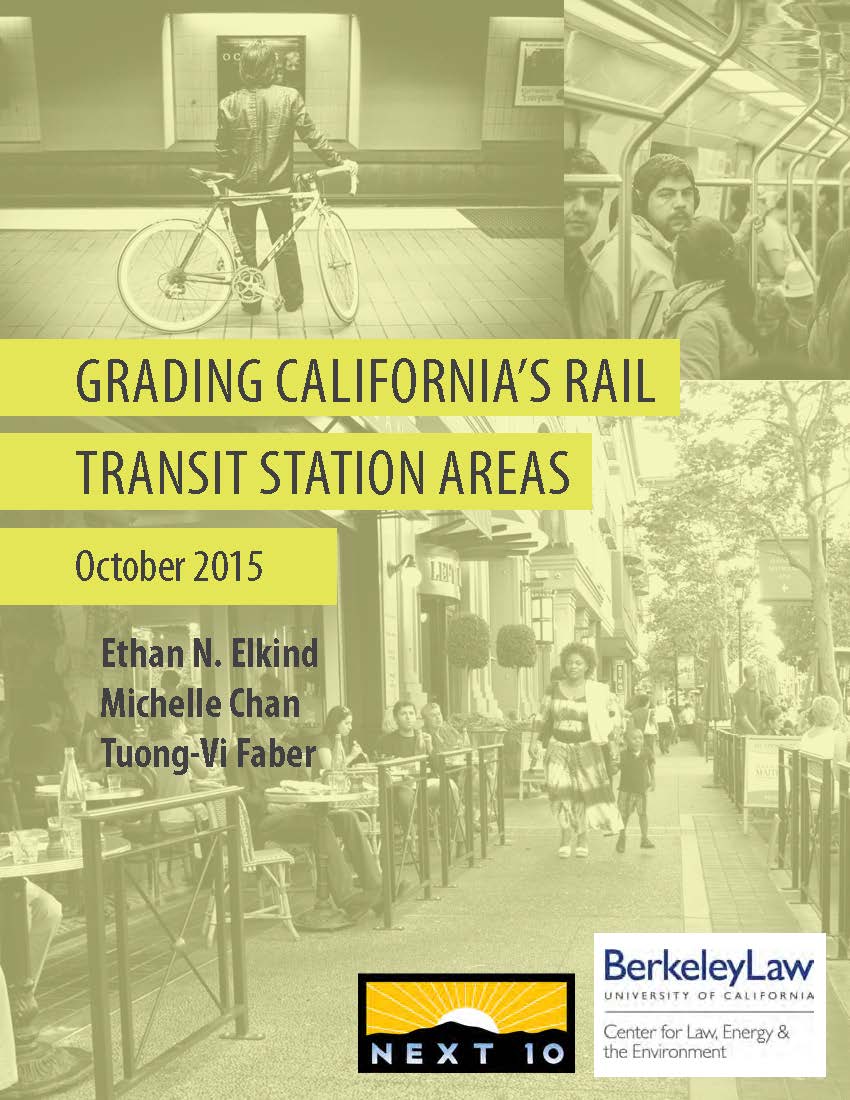 stations serve as hubs of thriving, walkable areas that encourage residents and workers alike to ride the train, and which station areas need improvement. The report divided rail transit station areas into three types: residential, employment, and mixed, and calculated grades based on 11 key indicators including walkability, ridership levels, existing land-use and permitting policies, affordability and transit quality.
stations serve as hubs of thriving, walkable areas that encourage residents and workers alike to ride the train, and which station areas need improvement. The report divided rail transit station areas into three types: residential, employment, and mixed, and calculated grades based on 11 key indicators including walkability, ridership levels, existing land-use and permitting policies, affordability and transit quality.
Key findings: The grades reveal that high-performing stations are often in the middle of transit systems in downtown-like environments, while the poorest-performing stations are often located at the outer edges of the rail systems and the urban areas. Low density, auto-oriented areas, even when graded against similar place types, scored poorly.
Also see our op-ed in the San Diego Union-Tribune.
February 2015
Moving Dollars: Aligning Transportation Spending With California’s Environmental Goals
California’s state, regional and local 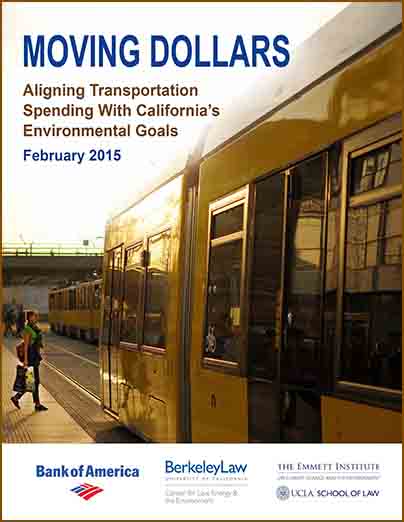 governments spend roughly $28 billion each year on transportation, with the majority of the funding for highways and other auto-oriented infrastructure. Yet state laws related to greenhouse gas reduction, more compact real estate development, and multimodal transportation options, such as walking and biking, necessitate reductions in vehicle miles traveled.
governments spend roughly $28 billion each year on transportation, with the majority of the funding for highways and other auto-oriented infrastructure. Yet state laws related to greenhouse gas reduction, more compact real estate development, and multimodal transportation options, such as walking and biking, necessitate reductions in vehicle miles traveled.
Key policy recommendations: State-developed project performance standards to ensure new transportation projects meet various sustainability metrics, a greater percentage of transportation dollars directed to maintenance of existing infrastructure (including “complete streets” options), and improved transparency and decision-making in allocating transportation funds.
September 2013
Electric Vehicle Paradise: How Hawaii Can Lead the World in Deployment
High energy costs, significant adoption of residential and commercial solar photovoltaic panels to reduce electricity costs, and limited driving range due to the island geographies make Hawai‘i a logical fit for mass electric vehicle adoption. This report summarizes the overarching barriers and opportunities for mass electric vehicle deployment in the state and assesses the specific challenges and opportunities on each the islands.
Key policy recommendations: Improve electricity rate structures and coordinate business partnerships to expand charging infrastructure, facilitate new fleet purchases of electric vehicles, and remove restrictions on net metering to encourage greater adoption of commercial and residential solar.
August 2013
A High Speed Foundation: How to Build a Better California Around High Speed Rail
California will soon begin construction of a proposed high speed rail system in the San Joaquin Valley, which will ultimately connect to Los Angeles and San Francisco. If implemented poorly, however, the system could lead to unchecked development in the Valley that could increase traffic, exacerbate the loss of farmland, and generate more air pollution.
Key policy recommendations: a Valley-wide collaborative to create a plan for economic growth and environmental preservation around the high speed rail network, support for local planning and mitigation efforts to implement it, and new financing mechanisms to catalyze private investment in station-connected development.
Also see our webcast presentation featuring Fresno mayor, Ashley Swearengin.
September 2012
Electric Drive by ’25: How California Can Catalyze Mass Adoption of Electric Vehicles by 2025
Long term, mass consumer adoption of electric vehicles will help California meet its renewable energy and greenhouse gas goals while boosting the economy with domestically produced fuel (in the form of electricity) and sales from California-based electric vehicle companies and suppliers.
Key policy recommendations: Industry and policy-maker coordinated education and outreach campaign about the consumer benefits of electric vehicle technology, reduced taxes and fees to lower the upfront cost of the vehicles, and a well-planned and coordinate public charging infrastructure.
Also see our webcast lunch briefing accompanying the release of this report.
July 2011
All Aboard: How California Can Increase Investments in Public Transportation
A well-funded and comprehensive public transit system in California could help the state reduce greenhouse gas emissions associated with driving and save residents and businesses time and money.
Key policy recommendations: State policies that lower the threshold for voter approval of transit tax measures, authorization of tax increment financing for transit improvements, better land use surrounding transit stations, and more efficient use of existing transit resources and infrastructure development.
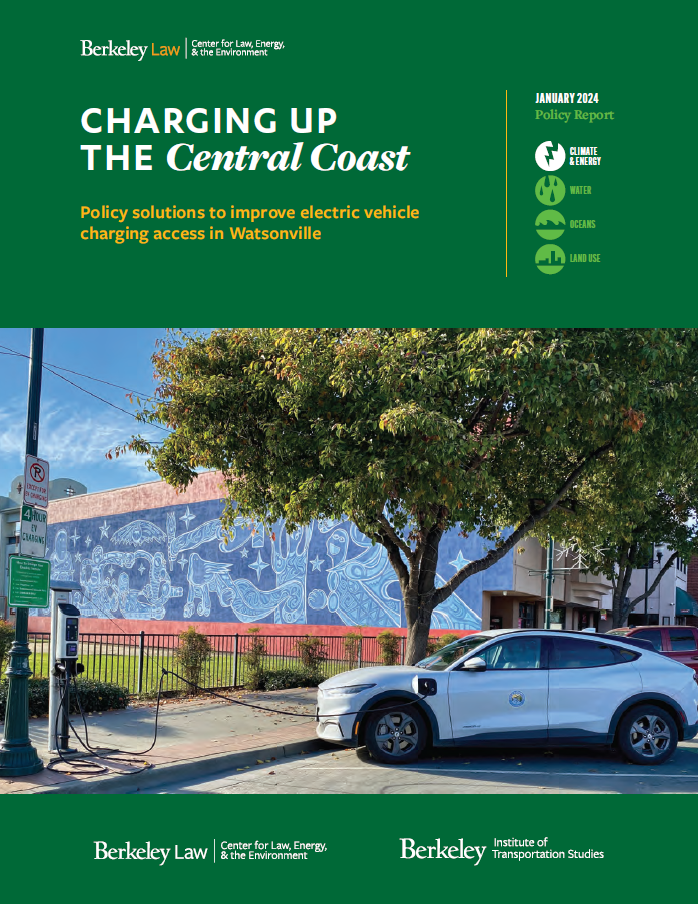
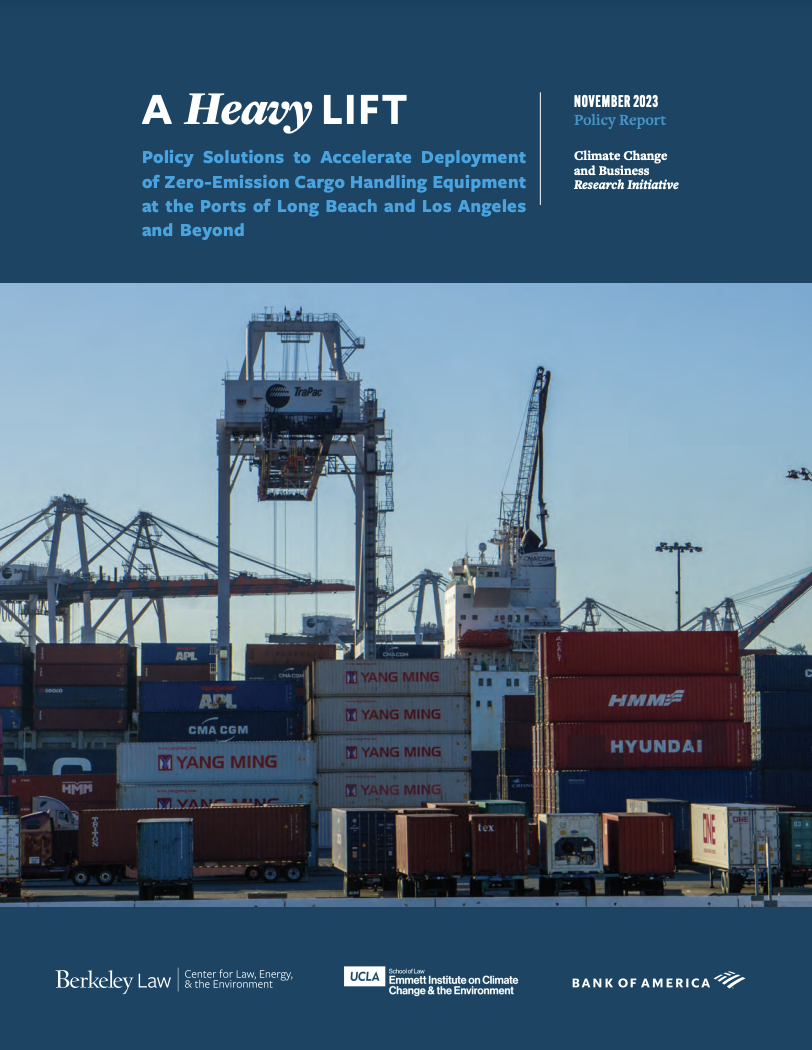

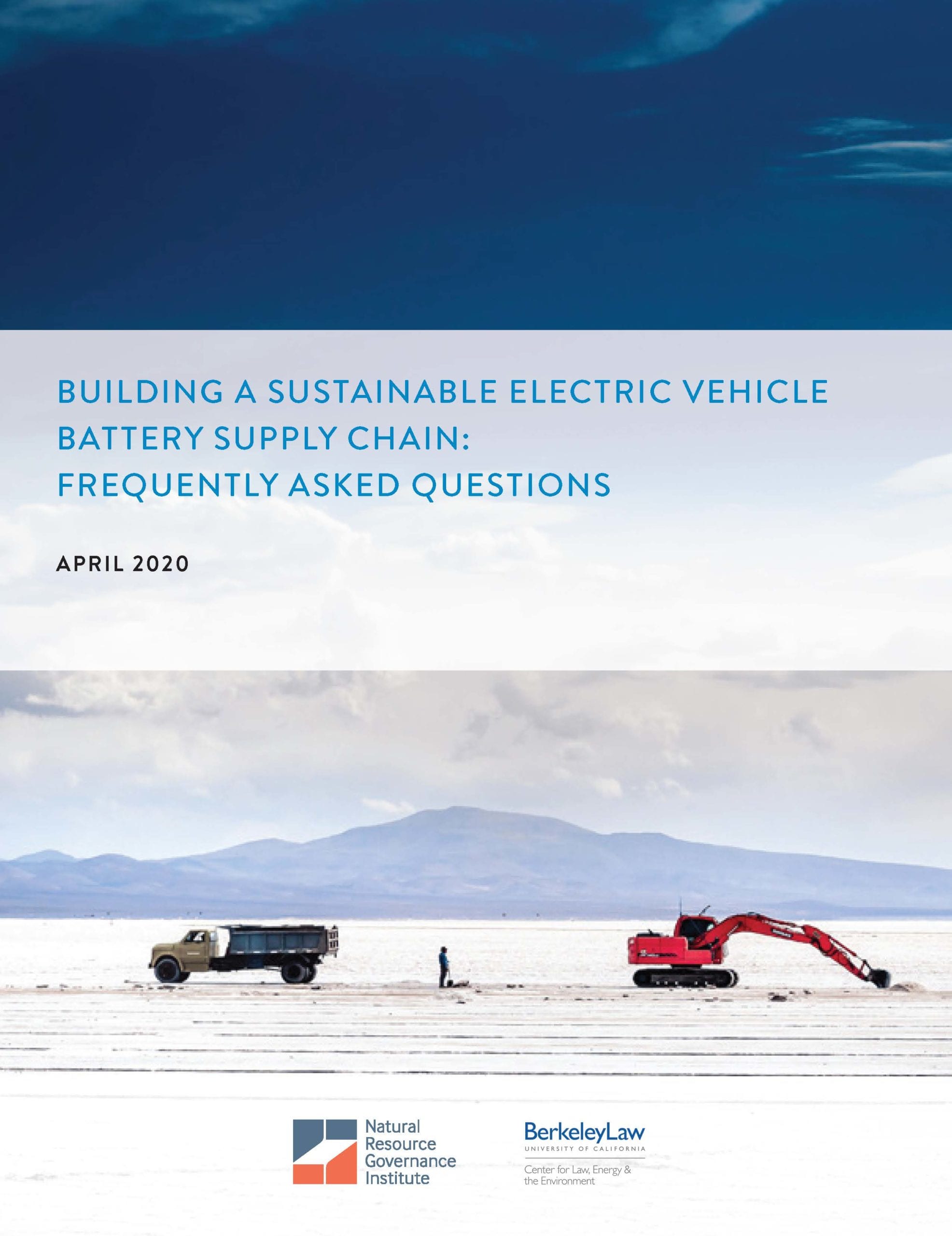
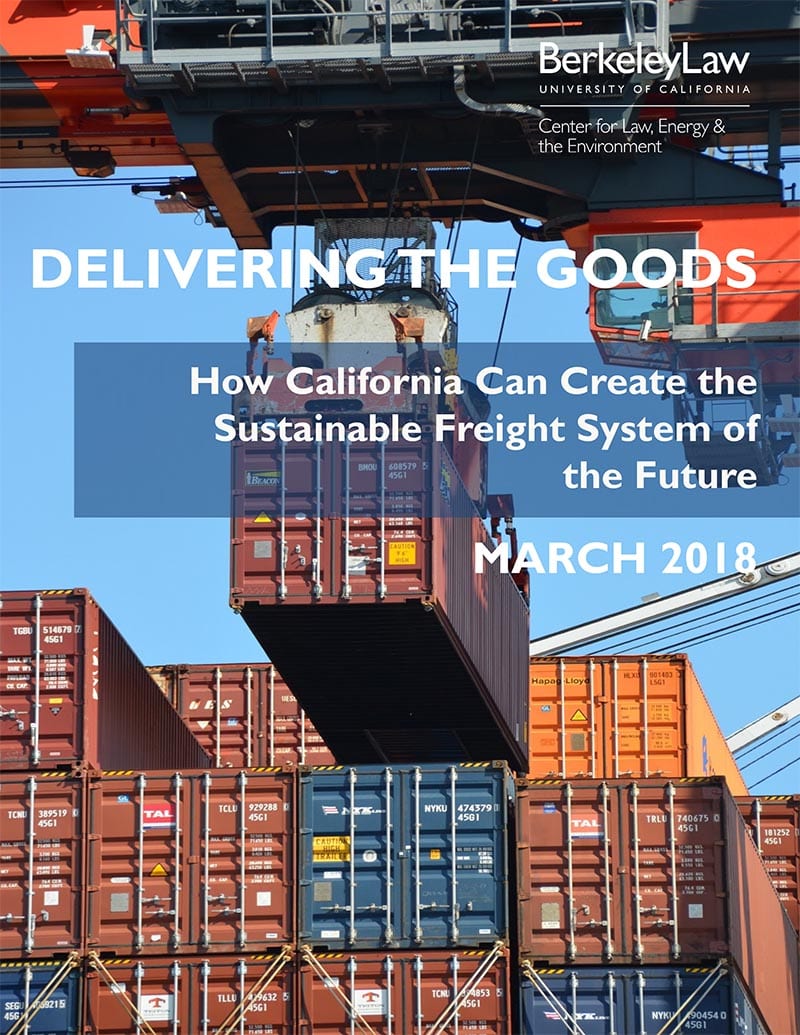
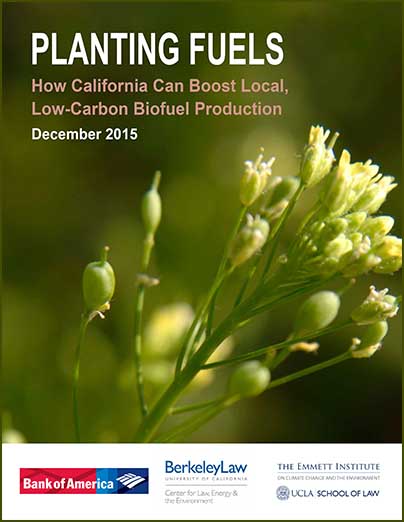
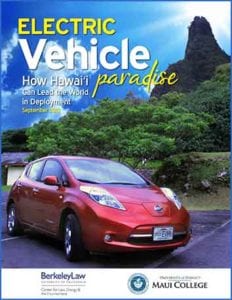
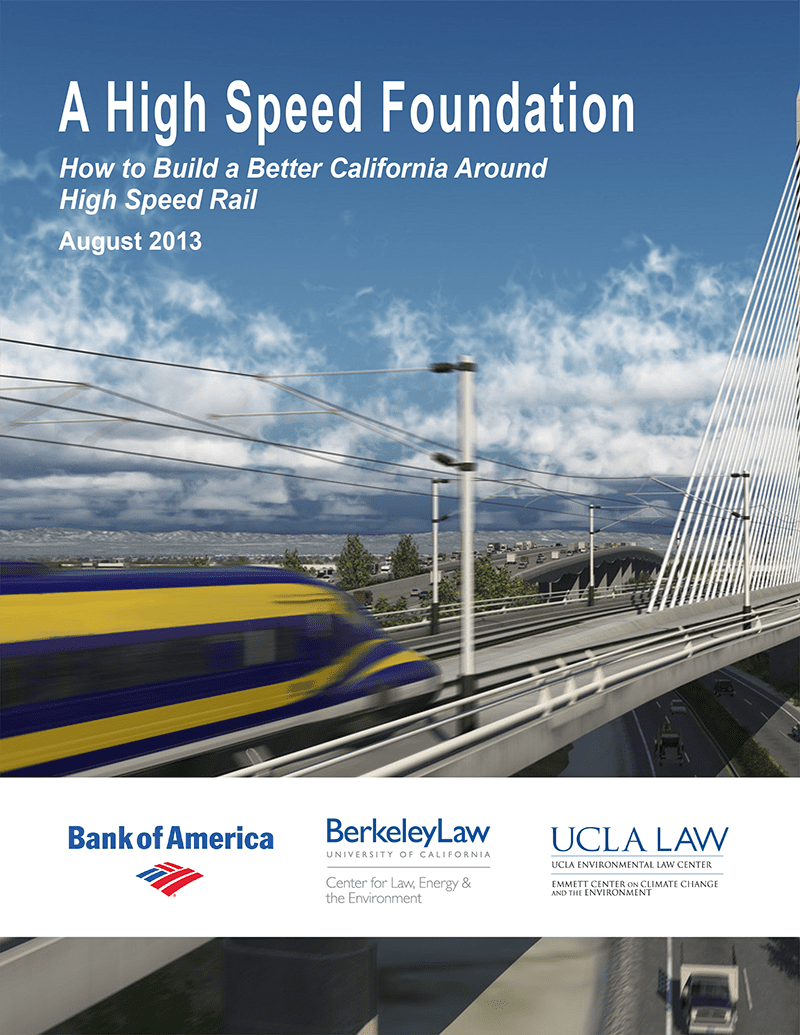
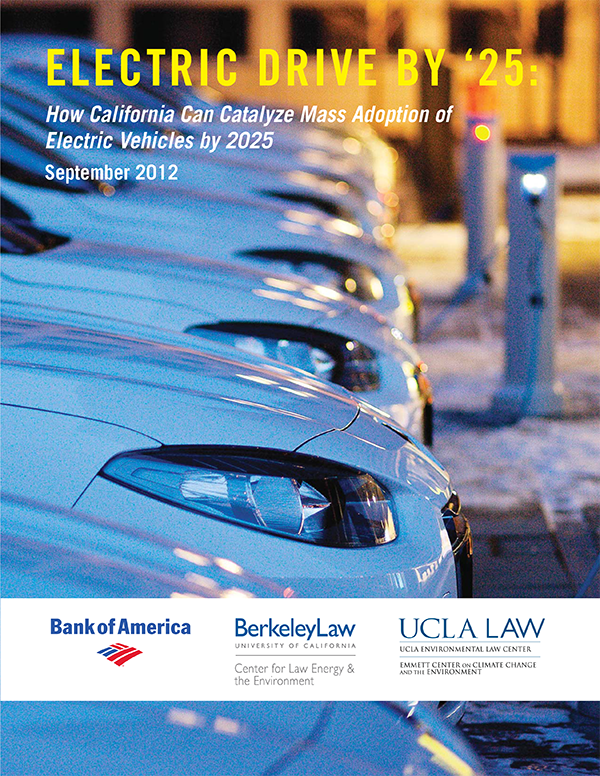
.jpg)